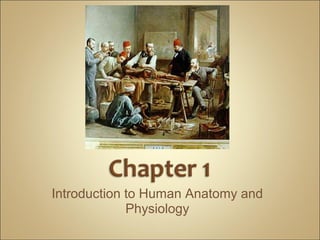
Anatomy and physiology Introduction Chapter 1 Notes
- 1. Introduction to Human Anatomy and Physiology
- 2. Mr. Hunter 09/20/2012 • Objective(s) • SWBAT • Name the orientations of the anatomical position • Name and identify the body cavities • Bell Ringer: Define Homeostasis.
- 3. Exit Question(s) 1. List the levels of organization of a living organism. 2. Name the two parts of the Serous Membrane
- 4. • Anatomy – the structure of body parts (also called Morphology) • Physiology – the function of the body parts, what they do and how they do it
- 5. • Movement - self initiated change in position, motion of internal parts • Responsiveness (irritability) - Ability to sense changes within, or around the organism and react to them • Growth - increase in body size • Reproduction - Parents produce offspring / producing new individuals • Respiration - Obtaining oxygen (O2), using it to release energy from food substances, and getting rid of wastes
- 6. • Digestion - Chemically changing (breaking down) food substances, and getting rid of wastes • Absorption - Passage of Digested products (food substances) through membranes and into body fluids • Circulation - Movement of substances throughout the body • Assimilation - Changing absorbed substances into chemically different substances • Excretion - Removal of wastes
- 7. • I am walking to Mcdonalds (movement) • I stop at the traffic light (response) • My body is growing (growth) • I am breathing air (respiration) • I get a hamburger and eat it (digestion) • My body absorbs the hamburger (absorption) • The hamburger circulates in my body (circulation) • The hamburger is changed to things my body needs (assimilation) • Eventually, I go to the bathroom (excretion) • Someday I may reproduce (reproduction)
- 8. • Metabolism = all the physical and chemical changes • Bodily needs = food, oxygen, water, heat • Homeostasis = tendency of the body to maintain a stable, balanced, internal environment. “Sameness”
- 9. • Feedback systems are cycle of events in which the status of a Homeostasis condition is monitored, evaluated, changed and remonitored. • Each monitored variable is called a controlled condition. • Any disruption that changes a controlled condition is called a stimulus. • Three components of a feedback system are: a receptor, a control center and an effector.
- 10. • Receptors monitors changes in a controlled condition. It sends input Homeostasis in the form of nerve impulses or chemical signals to a control center. Ex. Nerve endings in the skin can sense temperature. • A control center sets the range of values which a controlled condition should be maintained, evaluates the input from receptors, and generate output commands – nerve impulses, chemical signals / hormones • Effectors are structures that receives output from the control center and produces a response.
- 14. • Axial Portion - head, neck, trunk • Appendicular Portion - arms & legs 1. Several body cavities 2. Layers of membranes within cavities 3. Variety of organs and organ systems within cavities (VISCERA = internal organs. "Visceral organs")
- 15. Popular in horror movies and games
- 16. Body Cavities Dorsal = back side Ventral = front side Thoracic = chest (heart, trachea, lungs..) Abdomen = stomach area (spleen, intestines) Pelvic = lower abdomen (bladder, reproductive organs) DIAPHRAGM: Separates the thoracic and pelvic region SEROUS MEMBRANE - covers and surrounds organs SERIOUS FLUID - lubricates organs
- 17. It's easier to visualize the body cavities on pictures - see Body Cavity Label | Label 2 Label the body cavities (use your book)
- 20. • Serous Membrane - two layered, covers organs o Outer layer = parietal o Inner layer = visceral (lines the organs) • Serous fluid – lubricating fluid
- 21. • Pleura = lungs • Pericardium = heart • Peritoneum = organs (abdominopelvic region)
- 22. Visceral Pleura / Parietal Pleura Visceral Pericardium / Parietal Pericardium Visceral Peritoneum / Parietal Peritoneum
- 23. Homework: Organ Systems Concept Map
- 24. Anatomical Terminology Anatomical Position = standing erect, face forward, arms at side, palms facing forward *Study and learn the following terms* 1. Superior 2. Inferior 3. Anterior 4. Posterior 5. Medial 6. Lateral 7. Proximal 8. Distal 9. Superficial 10. Deep
- 27. Homework: Fill out the chart on the body regions
- 28. Homework: Fill out the chart on the body regions
- 29. • There are tons of careers, some of them only require a short term of training. What are your goals? • See Explore Health Careers • Homework: Medical and Applied Science